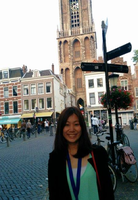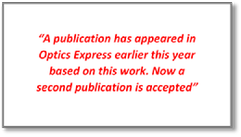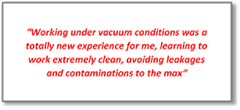 In this thesis a unique XUV source based on high-harmonic generation method is investigated. Using waveguides allows for spatial and spectral control. There are a number of fundamentally different approaches. ‘For example free-electron lasers (FELs) - which deliver the highest brightness used in many XUV applications - are requiring lots of space and are lacking temporal coherence,’ Siew Jean Goh says. ‘The aim is to one day design a compact table top device based on high-harmonic generation which delivers bright and fully coherent XUV output for seeding FEL. Important steps are made towards this, generating more coherent output. Our studies have shown waveguided high-harmonic generation to be particularly suited for producing radiation at XUV wavelengths, with excellent beam coherence and unique spectral features.’
In this thesis a unique XUV source based on high-harmonic generation method is investigated. Using waveguides allows for spatial and spectral control. There are a number of fundamentally different approaches. ‘For example free-electron lasers (FELs) - which deliver the highest brightness used in many XUV applications - are requiring lots of space and are lacking temporal coherence,’ Siew Jean Goh says. ‘The aim is to one day design a compact table top device based on high-harmonic generation which delivers bright and fully coherent XUV output for seeding FEL. Important steps are made towards this, generating more coherent output. Our studies have shown waveguided high-harmonic generation to be particularly suited for producing radiation at XUV wavelengths, with excellent beam coherence and unique spectral features.’

Siew Jean compares using waveguided high-harmonic generation for seeding SASE-FEL (self-amplified spontaneous emission) to radio-amplifying phenomena. ‘A nice input will generate a nice amplified output,’ she says. ‘The principle under study, was shown already for longer wavelengths. At the beginning of my PhD project the investigation curiosity was there to show this could work for XUV wavelength as well.’
Conversion efficiency
Apart from the shot-to-shot output stability and tunability, the conversion efficiency is still another feature to be worked on. Progress on this has been made. Nevertheless, future research is needed on using higher drive laser energies and larger waveguide diameters, Siew Jean concludes, in order to achieve higher XUV output energies.
Efforts to pursue these goals further are worthwhile, Siew Jean strongly believes. ‘During this thesis project we have used our XUV source on other application already, clearly showing its potential,’ she says. ‘We were able to characterize XUV transmission gratings using this source, and we optically characterized grating resolutions and the relative strength of the second diffraction orders, thus gaining more insight into the grating’s nanostructure. A publication has appeared in Optics Express earlier this year based on this work. Now a second publication is accepted, which is a nice surprise.’
Dark lab

For her vast experimental work Siew Jean spent many hours in the ‘dark lab’ of the Laser Physics and Nonlinear Optics Group, wearing green “laser Goggles” most of the time.
‘With the help of the technicians we were able to scale up our generation output by increasing our hollow waveguide diameters. During the PhD I learned to work with high-powered, ultrafast lasers, which was very different from my master’s work in Scotland, involving small diode lasers and more common wavelengths. Also working under vacuum conditions was a totally new experience for me, learning to work extremely clean, avoiding leakages and contaminations to the max.

‘Also collaboration is an important feature of scientific research, I learned. With collaboration, I could build into my experimental setup the transmission grating, fabricated by the XUV Industrial Focus group, and use the evolutionary algorithms obtained from the Optical Science Group, here at Mesa+.’
Optics and laser physics
When thinking about her future work, Siew Jean is open to either academic research or application oriented research activities in industry. Siew Jean: ‘At first thought, I am more tilted towards a job in industry which offers more security than will be possible in research in which contract periods of two or three years are common ground, and grant money systems are unpredictable as well. But at the end of the day, it really depends on how interesting I find the work to be. I hope optics and laser physics will again be at the heart of my work.’
